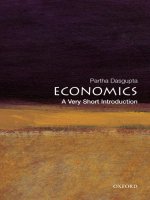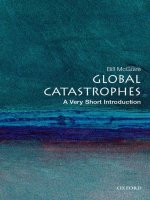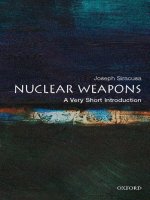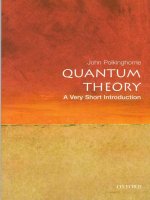- Trang chủ >>
- Khoa Học Tự Nhiên >>
- Vật lý
Nuclear weapons: A very short introduction
Bạn đang xem bản rút gọn của tài liệu. Xem và tải ngay bản đầy đủ của tài liệu tại đây (1.4 MB, 161 trang )
Nuclear Weapons: A Very Short Introduction
AFRICAN HISTORY
John Parker and Richard Rathbone
AMERICAN POLITICAL PARTIES
AND ELECTIONS L. Sandy Maisel
THE AMERICAN PRESIDENCY
Charles O. Jones
ANARCHISM Colin Ward
ANCIENT EGYPT Ian Shaw
ANCIENT PHILOSOPHY Julia Annas
ANCIENT WARFARE
Harry Sidebottom
ANGLICANISM Mark Chapman
THE ANGLO-SAXON AGE John Blair
ANIMAL RIGHTS
David DeGrazia
ANTISEMITISM Steven Beller
ARCHAEOLOGY Paul Bahn
ARCHITECTURE Andrew Ballantyne
ARISTOTLE Jonathan Barnes
ART HISTORY Dana Arnold
ART THEORY Cynthia Freeland
THE HISTORY OF ASTRONOMY
Michael Hoskin
ATHEISM Julian Baggini
AUGUSTINE Henry Chadwick
BARTHES Jonathan Culler
BESTSELLERS John Sutherland
THE BIBLE John Riches
THE BRAIN Michael O’Shea
BRITISH POLITICS Anthony Wright
BUDDHA Michael Carrithers
BUDDHISM Damien Keown
BUDDHIST ETHICS Damien Keown
CAPITALISM James Fulcher
THE CELTS Barry Cunliffe
CHAOS Leonard Smith
CHOICE THEORY Michael Allingham
CHRISTIAN ART Beth Williamson
CHRISTIANITY Linda Woodhead
CLASSICS
Mary Beard and John Henderson
CLASSICAL MYTHOLOGY
Helen Morales
CLAUSEWITZ Michael Howard
THE COLD WAR Robert McMahon
CONSCIOUSNESS Susan Blackmore
CONTEMPORARY ART
Julian Stallabrass
CONTINENTAL PHILOSOPHY
Simon Critchley
COSMOLOGY Peter Coles
THE CRUSADES Christopher Tyerman
CRYPTOGRAPHY
Fred Piper and Sean Murphy
DADA AND SURREALISM
David Hopkins
DARWIN Jonathan Howard
THE DEAD SEA SCROLLS Timothy Lim
DEMOCRACY Bernard Crick
DESCARTES Tom Sorell
DESIGN John Heskett
DINOSAURS David Norman
DOCUMENTARY FILM
Patricia Aufderheide
DREAMING J. Allan Hobson
DRUGS Leslie Iversen
THE EARTH Martin Redfern
ECONOMICS Partha Dasgupta
EGYPTIAN MYTH Geraldine Pinch
VERY SHORT INTRODUCTIONS are for anyone wanting a stimulating
and accessible way in to a new subject. They are written by experts, and have
been published in more than 25 languages worldwide.
The series began in 1995, and now represents a wide variety of topics in
history, philosophy, religion, science, and the humanities. Over the next
few years it will grow to a library of around 200 volumes – a Very Short
Introduction to everything from ancient Egypt and Indian philosophy to
conceptual art and cosmology.
Very Short Introductions available now:
EIGHTEENTH-CENTURY BRITAIN
Paul Langford
THE ELEMENTS Philip Ball
EMOTION Dylan Evans
EMPIRE Stephen Howe
ENGELS Terrell Carver
ETHICS Simon Blackburn
THE EUROPEAN UNION
John Pinder and Simon Usherwood
EVOLUTION
Brian and Deborah Charlesworth
EXISTENTIALISM Thomas Flynn
FASCISM Kevin Passmore
FEMINISM Margaret Walters
THE FIRST WORLD WAR
Michael Howard
FOSSILS Keith Thomson
FOUCAULT Gary Gutting
THE FRENCH REVOLUTION
William Doyle
FREE WILL Thomas Pink
FREUD Anthony Storr
FUNDAMENTALISM Malise Ruthven
GALAXIES John Gribbin
GALILEO Stillman Drake
GAME THEORY Ken Binmore
GANDHI Bhikhu Parekh
GEOPOLITICS Klaus Dodds
GERMAN LITERATURE Nicholas Boyle
GLOBAL CATASTROPHES Bill McGuire
GLOBALIZATION Manfred Steger
GLOBAL WARMING Mark Maslin
THE GREAT DEPRESSION AND
THE NEW DEAL Eric Rauchway
HABERMAS James Gordon Finlayson
HEGEL Peter Singer
HEIDEGGER Michael Inwood
HIEROGLYPHS Penelope Wilson
HINDUISM Kim Knott
HISTORY John H. Arnold
HIV/AIDS Alan Whiteside
HOBBES Richard Tuck
HUMAN EVOLUTION Bernard Wood
HUMAN RIGHTS Andrew Clapham
HUME A. J. Ayer
IDEOLOGY Michael Freeden
INDIAN PHILOSOPHY Sue Hamilton
INTELLIGENCE Ian J. Deary
INTERNATIONAL MIGRATION
Khalid Koser
INTERNATIONAL RELATIONS
Paul Wilkinson
ISLAM Malise Ruthven
JOURNALISM Ian Hargreaves
JUDAISM Norman Solomon
JUNG Anthony Stevens
KABBALAH Joseph Dan
KAFKA Ritchie Robertson
KANT Roger Scruton
KIERKEGAARD Patrick Gardiner
THE KORAN Michael Cook
LAW Raymond Wacks
LINGUISTICS Peter Matthews
LITERARY THEORY Jonathan Culler
LOCKE John Dunn
LOGIC Graham Priest
MACHIAVELLI Quentin Skinner
THE MARQUIS DE SADE John Phillips
MARX Peter Singer
MATHEMATICS Timothy Gowers
MEDICAL ETHICS Tony Hope
MEDIEVAL BRITAIN
John Gillingham and Ralph A. Griffiths
MODERN ART David Cottington
MODERN CHINA Rana Mitter
MODERN IRELAND Senia Pašeta
MOLECULES Philip Ball
MUSIC Nicholas Cook
MYTH Robert A. Segal
NATIONALISM Steven Grosby
THE NEW TESTAMENT AS
LITERATURE Kyle Keefer
NEWTON Robert Iliffe
NIETZSCHE Michael Tanner
NINETEENTH-CENTURY BRITAIN
Christopher Harvie and
H. C. G. Matthew
NORTHERN IRELAND
Marc Mulholland
NUCLEAR WEAPONS
Joseph M. Siracusa
PARTICLE PHYSICS Frank Close
PAUL E. P. Sanders
PHILOSOPHY Edward Craig
PHILOSOPHY OF LAW
Raymond Wacks
PHILOSOPHY OF SCIENCE
Samir Okasha
PHOTOGRAPHY Steve Edwards
PLATO Julia Annas
POLITICS Kenneth Minogue
POLITICAL PHILOSOPHY
David Miller
POSTCOLONIALISM Robert Young
POSTMODERNISM
Christopher Butler
POSTSTRUCTURALISM
Catherine Belsey
PREHISTORY Chris Gosden
PRESOCRATIC PHILOSOPHY
Catherine Osborne
PSYCHOLOGY
Gillian Butler and Freda McManus
PSYCHIATRY Tom Burns
THE QUAKERS Pink Dandelion
QUANTUM THEORY
John Polkinghorne
RACISM Ali Rattansi
THE RENAISSANCE Jerry Brotton
RENAISSANCE ART
Geraldine A. Johnson
ROMAN BRITAIN Peter Salway
THE ROMAN EMPIRE
Christopher Kelly
ROUSSEAU Robert Wokler
RUSSELL A. C. Grayling
RUSSIAN LITERATURE Catriona Kelly
THE RUSSIAN REVOLUTION
S. A. Smith
SCHIZOPHRENIA
Chris Frith and Eve Johnstone
SCHOPENHAUER Christopher Janaway
SHAKESPEARE Germaine Greer
SIKHISM Eleanor Nesbitt
SOCIAL AND CULTURAL
ANTHROPOLOGY
John Monaghan and Peter Just
SOCIALISM Michael Newman
SOCIOLOGY Steve Bruce
SOCRATES C. C. W. Taylor
THE SPANISH CIVIL WAR
Helen Graham
SPINOZA Roger Scruton
STUART BRITAIN John Morrill
TERRORISM Charles Townshend
THEOLOGY David F. Ford
THE HISTORY OF TIME
Leofranc Holford-Strevens
TRAGEDY Adrian Poole
THE TUDORS John Guy
TWENTIETH-CENTURY BRITAIN
Kenneth O. Morgan
THE VIKINGS Julian Richards
WITTGENSTEIN A. C. Grayling
WORLD MUSIC Philip Bohlman
THE WORLD TRADE
ORGANIZATION
Amrita Narlikar
Available soon:
For more information visit our website
www.oup.co.uk/general/vsi/
1066 George Garnett
EXPRESSIONISM Katerina Reed-Tsocha
GEOGRAPHY
John Matthews and David Herbert
HISTORY OF MEDICINE
William Bynum
MEMORY Jonathan Foster
NELSON MANDELA
Elleke Boehmer
SCIENCE AND RELIGION
Thomas Dixon
SEXUALITY Véronique Mottier
THE MEANING OF LIFE
Terry Eagleton
Joseph M. Siracusa
Nuclear
Weapons
A Very Short Introduction
1
1
Great Clarendon Street, Oxford OX2 6DP
Oxford University Press is a department of the University of Oxford.
It furthers the University’s objective of excellence in research, scholarship,
and education by publishing worldwide in
Oxford New York
Auckland Cape Town Dar es Salaam Hong Kong Karachi
Kuala Lumpur Madrid Melbourne Mexico City Nairobi
New Delhi Shanghai Taipei Toronto
With offi ces in
Argentina Austria Brazil Chile Czech Republic France Greece
Guatemala Hungary Italy Japan Poland Portugal Singapore
South Korea Switzerland Thailand Turkey Ukraine Vietnam
Oxford is a registered trade mark of Oxford University Press
in the UK and in certain other countries
Published in the United States
by Oxford University Press Inc., New York
Joseph M. Siracusa 2008
The moral rights of the author have been asserted
Database right Oxford University Press (maker)
First published 2008
All rights reserved. No part of this publication may be reproduced,
stored in a retrieval system, or transmitted, in any form or by any means,
without the prior permission in writing of Oxford University Press,
or as expressly permitted by law, or under terms agreed with the appropriate
reprographics rights organization. Enquiries concerning reproduction
outside the scope of the above should be sent to the Rights Department,
Oxford University Press, at the address above
You must not circulate this book in any other binding or cover
and you must impose the same condition on any acquirer
British Library Cataloguing in Publication Data
Data available
Library of Congress Cataloging in Publication Data
Data available
ISBN 978–0–19–922954–3
1 3 5 7 9 10 8 6 4 2
Typeset by SPI Publisher Services, Pondicherry, India
Printed in Great Britain by
Ashford Colour Press Ltd, Gosport, Hampshire
For my wife, Candice
This page intentionally left blank
Contents
Preface xi
List of illustrations xv
1
What are nuclear weapons? 1
2
Building the bomb 10
3
‘A choice between the quick and the dead’ 27
4
Race for the H-bomb 40
5
Nuclear deterrence and arms control 61
6
Star Wars 82
7
Nuclear weapons in the age of terrorism 108
References and further reading 130
Index 139
This page intentionally left blank
Preface
This book will consider the most important, common, and
recurring questions about the development of nuclear weapons
and the policies they have generated. The discussion rests on a
single premise: the bomb still matters. Nuclear weapons have
not been used in anger since Hiroshima and Nagasaki, more
than 60 years ago, yet real concerns about their potential use
have remained conspicuously present on the global stage. As
president Bill Clinton’s fi rst Secretary of Defense, Les Aspin, aptly
put it: ‘The Cold War is over, the Soviet Union is no more. But
the post-Cold War world is decidedly not post-nuclear.’ For all
the effort for nuclear stockpiles to be reduced down to zero, for
the foreseeable future, the bomb is here to stay. Gone may be the
days when living with the bomb meant, in the words of former
Secretary of State Madeleine Albright, ‘Each night we knew that
within minutes, perhaps through a misunderstanding, our world
could end and morning never come’, but if the threat of global
thermonuclear war has receded, it has not disappeared. For all
our efforts, the prospect of a global post-nuclear age has not
progressed much further than wishful thinking. In fact, according
to a survey of nuclear experts compiled by the US Senate Foreign
Relations Committee in 2005, the world faces a 29% probability
that there will be a nuclear strike within the next 10 years. Few
dispute this consensus.
Nuclear threats remain fundamental to relations between many
states and threaten to become more important. The spread of
nuclear weapons will likely spawn two potentially calamitous
effects. The fi rst is the threat that terrorists will get their hands on
nuclear weapons, a threat that has come into stark relief since the
events of 9/11. To be sure, the followers of Osama bin Laden have
not yet succeeded in initiating a nuclear attack. But, according to
nuclear analysts, it’s not because they can’t. With a small quantity
of enriched uranium, a handful of military supplies readily
available on the Internet, and a small team of dedicated terrorists,
they could potentially assemble a nuclear weapon in a matter
of months, and deliver it by air, sea, rail, or road. The impact
of such an attack in the heart of New York or London is almost
unimaginable.
A second effect of the spread of nuclear weapons will be the
proliferation of threats to use them, greatly complicating global
security and in many respects harder to undo. As more states
join the nuclear club to enhance their prestige or overcome
perceived insecurity, they will undergo their own nuclear
learning curve, a process for which, as the experience of the
nuclear states over the past 60 years has shown, there is no
guarantee of success. The likelihood of mishaps along the way is
only too real.
When the atomic bomb was unleashed on the mainland of Japan,
in August 1945, in the closing stages of World War II, it was
immediately apparent that this was not just another effi cient
weapon (though it was that, too, as the A-bomb proved more
effi cient than a conventional 1,000-plane raid). In many respects,
Hiroshima was not the kind of watershed moment that can only
be seen in retrospect. President Harry S. Truman described the
event to a startled world as the very ‘harnessing of the basic power
of the universe’. It was a view widely shared by infl uential atomic
scientists.
Seven years later, in 1952, the United States scaled the nuclear
ladder, detonating its fi rst thermonuclear device in the Pacifi c.
‘Mike’, as the bomb was designated, exploded with a force 500
times greater than the bomb detonated over Hiroshima, in the
process wiping the test island off the map. The H-bomb really
changed everything, transforming the very nature of war and
peace. Or, as Winston Churchill put it, ‘The atomic bomb, with
all its terror, did not carry us outside the scope of human control
or manageable events, in thought or action, in peace or war.
But … [with] the hydrogen bomb, the entire foundation of human
affairs was revolutionized.’ Indeed, it was a brave new world.
A sample of statistics from the nuclear age that followed provides
a sobering reminder of the scale of the problem. Upwards
of 128,000 nuclear weapons have been produced in the past
60 years, of which about 98% were produced by the United States
and the former Soviet Union. The nine current members of the
nuclear club – the United States, Russia, Great Britain, France,
India, Pakistan, China, Israel, and North Korea – still possess
about 27,000 operational nuclear weapons between them. At
least another 15 countries currently have on hand enough highly
enriched uranium for a nuclear weapon.
Within this context, we will look at the science of nuclear weapons
and how they differ from conventional weapons; the race to
beat Nazi scientists to the bomb; the history of early attempts to
control the bomb, through to the Soviet detonation of an atomic
device in August 1949; the race to acquire the H-bomb, with its
revolutionary implications; the history of nuclear deterrence and
arms control, against the backdrop of the changing international
landscape, from the Cold War to the present; the prospect and
promise of missile defence, from the end of World War II, through
Ronald Reagan’s dream of shielding the American homeland
from a massive Soviet ballistic attack (‘Star Wars’), through the
current administration’s reduced goal of defending against a small
number of ballistic missiles (National Missile Defense), launched
by a rogue state; and, fi nally, the threat and implications of
nuclear weapons in the so-called ‘age of terrorism’.
In the matter of acknowledgements, I should like to record my
debt to my friends and colleagues: Manfred Steger for drawing
Oxford University Press’s A Very Short Introduction series to my
attention; Latha Menon, OUP’s senior commissioning editor,
trade science, for her kind invitation to write this book and
unfailing encouragement; Richard Dean Burns for his generosity
in sharing his knowledge of arms control and disarmament;
and David G. Coleman for his trenchant insights into nuclear
deterrence and the making of international strategy. At the
personal level, this book owes much to the inspiration of my
children – Hanna, Tina, and Joseph – who have inherited the
troubled world the 20th century left them; and of course to
my wife Candice, to whom this book is dedicated. Needless to
say – but I shall say it anyway – I alone am responsible for any
errors.
Professor Joseph M. Siracusa
Director of Global Studies
Royal Melbourne Institute of Technology
Melbourne, Australia
List of illustrations
1 Structure of the atom 3
2 ‘Fat Man’ bomb 20
© 2003 TopFoto
3 ‘Little Boy’ bomb 21
© 2003 TopFoto
4 Atomic bomb cloud over
Hiroshima
24
© 2006 Jon Mitchell/TopFoto
5 Ethel and Julius Rosenberg 49
© Bettmann/Corbis
6 ‘Stars Wars’ defence system 98
7 Supporters of Dr
A. Q. Khan
122
© Shakil Adil/AP/PA Photos
8 Indian nuclear test site 127
© Kapoor Baldev/Sygma/ Corbis
The publisher and the author apologize for any errors or omissions in the
above list. If contacted they will be pleased to rectify these at the earliest
opportunity.
This page intentionally left blank
1
Chapter 1
What are nuclear weapons?
In 1951, the newly established US Federal Civil Defense
Administration (FCDA) commissioned production of a fi lm to
instruct children how to react in the event of a nuclear attack. The
result was Duck and Cover, a fi lm lasting nine minutes that was
shown in schools throughout the United States during the 1950s
and beyond. It featured a cartoon character, Bert the Turtle, who
‘was very alert’ and ‘knew just what to do: duck and cover’. At
the sound of an alarm or the fl ash of a brilliant light signalling a
nuclear explosion, Bert would instantly tuck his body under his
shell. It looked simple enough. And everyone loved the turtle.
Other FCDA initiatives of the early 1950s led to the creation of
the Emergency Broadcast System, food stockpiles, civil defence
classes, and public and private bomb shelters. The FCDA
commissioned other civil defence fi lms, but Duck and Cover
became the most famous of the genre. In 2004, the US Library
of Congress even included it in the National Film Registry of
‘culturally, historically or aesthetically’ signifi cant motion pictures,
a distinction it now shares with such feature-fi lm classics as
Birth of a Nation, Casablanca, and Schindler’s List. As I look
back at the time I was fi rst introduced to Bert the Turtle, in the
early 1950s, while attending primary school on the north side
of Chicago – America’s third largest city and long a favourite
hypothetical nuclear target – I realize of course that Bert the
2
Nuclear Weapons
Turtle had little to do with culture, history, or aesthetics and much
to do with propaganda. America’s schoolchildren would never
have known what hit them.
The science of nuclear weapons
Atomic energy is the source of power for both nuclear reactors
and nuclear weapons. This energy derives from the splitting
(fi ssion) or joining (fusion) of atoms. To understand the source of
this energy, one must fi rst appreciate the complexities of the atom
itself.
An atom is the smallest particle of an element that has the
properties characterizing that element. Knowledge about the
nature of the atom grew slowly until the early 1900s. One of the
fi rst breakthroughs was achieved by Sir Ernest Rutherford in 1911
when he established that the mass of the atom is concentrated in
its nucleus; he also proposed that the nucleus has a positive charge
and is surrounded by negatively charged electrons. This theory
of atomic structure was complemented several years later by
Danish physicist Niels Bohr, who placed the electrons in defi nite
shells or quantum levels. Thus an atom is a complex arrangement
of negatively charged electrons located in defi ned shells about a
positively charged nucleus. The nucleus, in turn, contains most of
the atom’s mass and is composed of protons and neutrons (except
for common hydrogen, which has only one proton). All atoms are
roughly the same size.
Furthermore, the negatively charged electrons follow a random
pattern within defi ned energy shells around the nucleus. Most
properties of atoms are based on the number and arrangement
of their electrons. One of the two types of particles found in the
nucleus is the proton, a positively charged particle. The proton’s
charge is equal but opposite to the negative charge of the electron.
The number of protons in the nucleus of an atom determines what
kind of chemical element it is. The neutron is the other type of
3
What are nuclear weapons?
particle found in the nucleus. Discovered by British physicist Sir
James Chadwick, in 1932, the neutron carries no electrical charge
and has the same mass as the proton. With a lack of electrical
charge, the neutron is not repelled by the cloud of electrons or by
the nucleus, making it a useful tool for probing the structure of
the atom. Even the individual protons and neutrons have internal
structures, called quarks, but these subatomic particles cannot be
freed and studied in isolation.
A major characteristic of an atom is its atomic number, which is
defi ned as the number of protons. The chemical properties of an
1. An atom consists of electrons, protons, and neutrons. The protons
and neutrons make up the dense atomic nucleus whilst the electrons
form a more dispersed electron cloud surrounding the nucleus
4
Nuclear Weapons
atom are determined by its atomic number. The total number
of what is called nucleons (protons and neutrons) in an atom is
the atomic mass number. Atoms with the same atomic number
but with different numbers of neutrons and, therefore, different
atomic masses are called isotopes. Isotopes have identical
chemical properties, yet have very different nuclear properties.
For example, there are three isotopes of hydrogen: two of these
are stable (not radioactive), but tritium (one proton and two
neutrons) is unstable. Most elements have stable isotopes.
Radioactive isotopes can also be treated for many elements. The
nucleus of the U-235 atom (the chemical sign for uranium is U)
comprises 92 protons and 143 neutrons (92 + 143 = 235) and is
thus written U
235
.
The mass of the nucleus is about 1% smaller than the mass of its
individual protons and neutrons. This difference is called the mass
defect, and arises from the energy released when the nucleons
(protons and neutrons) bind together to form the nucleus. This
energy is called binding energy, which in turn determines which
nuclei are stable and how much energy is released in a nuclear
reaction. Very heavy nuclei and very light nuclei have low binding
energies; this implies that a heavy nucleus will release energy
when it splits apart (fi ssion) and two light nuclei will release
energy when they join (fusion). The mass defect and binding
energy are famously related to Albert Einstein’s E = mc
2
.
In 1905, Einstein developed the special theory of relativity, one
of the implications of which was that matter and energy are
interchangeable with one another. This equation states that a
mass (m) can be converted into a tremendous amount of energy
(E), where c is the speed of light. Because the speed of light is a
large number (186,00 miles a second) and thus c squared is huge,
a small amount of matter can be converted into a tremendous
amount of energy. Einstein’s equation is the key to the power of
nuclear weapons and nuclear reactors. Fission reaction was used
in the fi rst atomic bomb and is still used in nuclear reactors, while
5
What are nuclear weapons?
fusion reaction became important in thermonuclear weapons and
in nuclear reactor development.
What is the practical signifi cance of a nuclear weapon, then?
And how does it differ from what came before? The fundamental
difference between a nuclear and conventional weapon is, simply
put, that nuclear explosions can be many thousands (or millions)
of times more powerful than the largest conventional explosion.
To be certain, both types of weapons rely on the destructive force
of the blast or shockwave. However, the temperatures reached in
a nuclear explosion are very much higher than in a conventional
explosion, and a large proportion of the energy in a nuclear
explosion is emitted in the form of light and heat, generally
referred to as thermal energy. This energy is capable of causing
severe skin burns and of starting fi res at considerable distances;
in fact, damage from the resulting fi restorm could be far more
devastating than the well-known blast effects.
Nuclear explosions are also accompanied by radioactive fallout,
lasting a few seconds, and remaining dangerous over an extended
period of time, potentially lasting years. The release of radiation
is, in fact, unique to nuclear explosions. Approximately 85% of
a nuclear weapon produces air blast (and shock) and thermal
energy (heat). The remaining 15% of the energy is released as
various types of radiation. Of this, 5% constitutes the initial
nuclear radiation, defi ned as that produced within a minute or
so of the explosion, and consisting mostly of powerful gamma
rays. The fi nal 10% of the total fi ssion energy represents that of
the residual (or delayed) nuclear radiation. This is largely due to
the radioactivity of the fi ssion products present in the weapon
residues, or debris, and fallout after the explosion.
Equally important is the amount of explosive energy that a
nuclear weapon can produce, usually measured as the yield. The
yield is given in terms of the quantity of conventional explosives
or TNT that would generate the same amount of energy when it
6
Nuclear Weapons
explodes. Thus, a 1 kiloton nuclear weapon is one that produces
the same amount of energy in an explosion as does 1,000 tons
of TNT; similarly, a 1 megaton weapon would have the energy
equivalent of 1 million tons of TNT.
The uranium-based weapon that destroyed Hiroshima in August
1945, the energy of which resulted from splitting (fi ssion) of
atoms, had the explosive force of 20,000 tons of TNT; the
thermonuclear or hydrogen bomb tested by the United States in
the Pacifi c in October 1952, the energy of which came from joining
(fusing) of atoms, had a yield estimated at 7 megatons or 7 million
tons of TNT and the production of lethal radioactive fallout from
gamma rays. This thermonuclear test was matched by the Soviet
Union in August 1953, launching the Cold War superpowers into
a deadly race up the nuclear ladder that lasted until the demise of
the Soviet Union in December 1991.
Unfortunately, the peaceful end of the Cold War did not mean
the end of nuclear threats to global security. Or, to quote former
British Prime Minister Tony Blair’s defence of his government’s
plan to update and replace the United Kingdom’s Trident
nuclear weapons system (see Chapter 7): ‘there is also a new
and potentially hazardous threat from states such as North
Korea which claims already to have developed nuclear weapons
or Iran which is in breach of its non-proliferation duties’, not
to mention the ‘possible connection between some of those
states and international terrorism’. Add to this stateless terrorist
organizations bent on acquiring the means of mass murder and
black-market networks of renegade suppliers only too willing
to deal in the materials and technical expertise that lead to
nuclear weapons, and the picture becomes clearer. The ensuing
nightmare of responding to the humanitarian, law and order, and
logistical challenges of a nuclear detonation could materialize
quite unexpectedly and spectacularly, in any large city, paling the
experience of 9/11.
7
What are nuclear weapons?
New York City scenario
For example, a relatively small nuclear weapon – say, in the order
of a 150 kiloton bomb – constructed by terrorists, detonated in the
heart of Manhattan, at the foot of the Empire State Building, at
noon on a clear spring day, would have catastrophic consequences.
At the end of the fi rst second, the shockwave, causing a sudden
change in ambient pressure of 20 pounds per square inch (psi)
at a distance of four-tenths of a mile from ground zero, would
have destroyed the great landmarks of Manhattan, including the
Empire State Building, Madison Square Gardens, Penn Central
Railroad Station, and the incomparable New York Public Library.
Most of the material that comprises these buildings would remain
and pile up to the depth of hundreds of feet in places, but nothing
inside this ring would be recognizable. Those caught outside the
circle would be exposed to the full effects of the blast, including
severe lung and ear drum damage, as well as exposure to fl ying
debris. Those in the direct line of sight of the blast would be
exposed to the thermal pulse and killed instantly, while those
shielded from some of the blast and thermal effects would be
killed as buildings collapse: roughly 75,000 New Yorkers would
be killed in these ways. During the next 15 seconds, the blast
and fi restorm would extend out for almost 4 miles, resulting in
750,000 additional fatalities and nearly 900,000 injuries. And
this would just be the beginning of New York’s problems.
The task of caring for the injured would literally be beyond the
ability, and perhaps even the imagination, of the medical system
to respond. All but one of Manhattan’s large hospitals lie inside
the blast area and would be completely destroyed. There aren’t
enough available hospital beds in all of New York and New Jersey
for even the most critically wounded. The entire country has a
total of only 3,000 beds in burn centres; thousands would die
from lack of medical attention. Meanwhile, most of New York
would be without electricity, gas, water, or sewage. Transportation
8
Nuclear Weapons
of the injured and the ability to bring in necessary supplies,
people, and equipment would be problematical. Tens of thousands
of New Yorkers would be homeless. The tasks of the emergency
responders, in areas that remained dangerously radioactive, would
pose possibly insuperable problems.
The terrorists’ explosion would have produced much more
early radioactive fallout than a similar-sized air burst in which
the fi reball never touches the ground. This is because a surface
explosion produces radioactive particles from the ground as well
as from the weapon. The early fallout would drift back to earth
on the prevailing wind, creating an elliptical pattern stretching
from ground zero out into Long Island. Because the wind would
be relatively light, the fallout would be concentrated in the area
of Manhattan, just to the east of the blast. Thousands of New
Yorkers would suffer serious radiation sickness effects, including
chromosomal damage, marrow and intestine destruction, and
haemorrhaging. Many would die of these conditions in the days
and the weeks ahead. Each survivor of the blast would have on
average about a 20% chance of dying of cancer of some form, and
another 80% probability of dying instead from other causes such
as heart disease or infection. The impact on the next generation
would come in the form of hereditary illness and birth defects.
In January 2007, the scientists who tend to the Doomsday
Clock moved it two minutes closer to midnight, the ultimate
symbol of the annihilation of civilization. The Bulletin of the
Atomic Scientists, which created the clock in 1947 to warn of the
dangers of nuclear weapons, advanced the clock to fi ve minutes
to midnight. ‘We stand at the brink of a second nuclear age’,
the group said in a statement, pointing to North Korea’s fi rst
test of a nuclear weapon in 2006, Iran’s nuclear ambitions, US
fl irtation with atomic ‘bunker busters’, and the 27,000 operational
nuclear weapons available to the nuclear club. The scientists also
reminded us that only 50 of today’s nuclear weapons could kill as
many as 200 million people.









